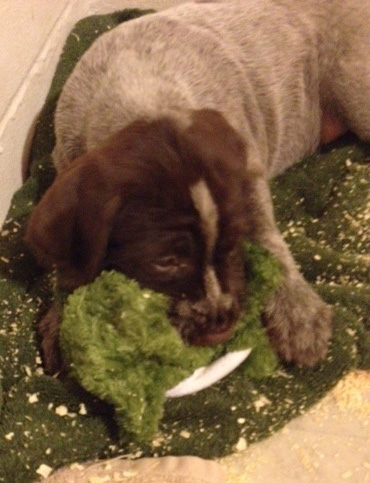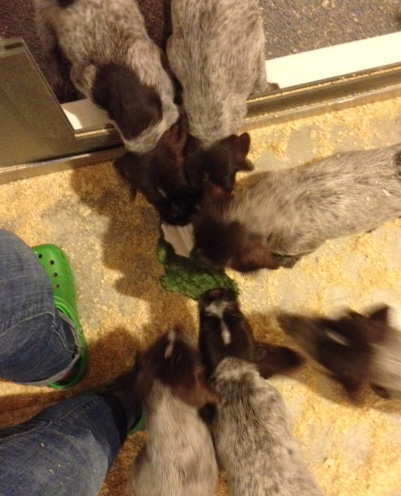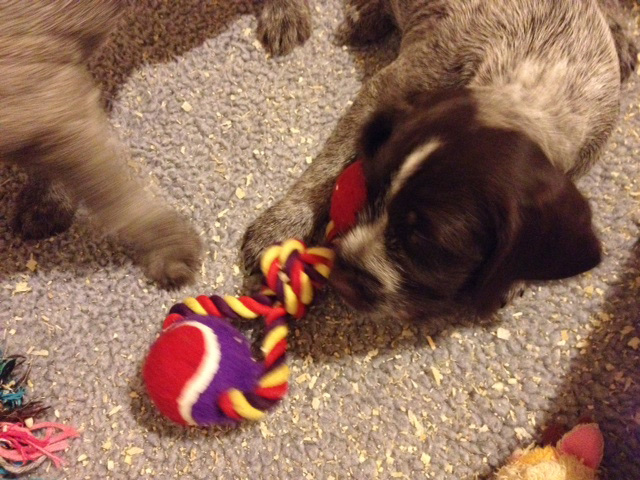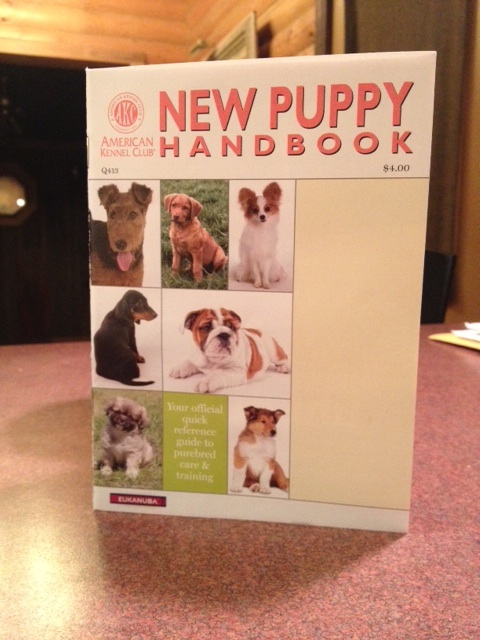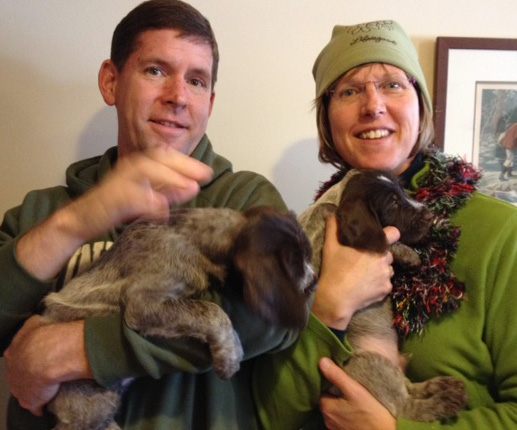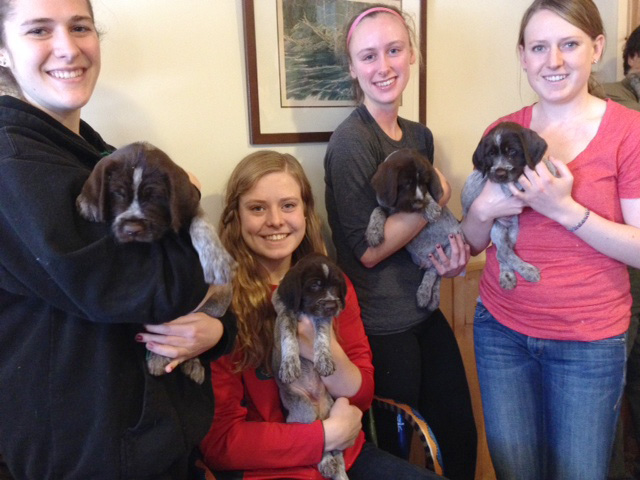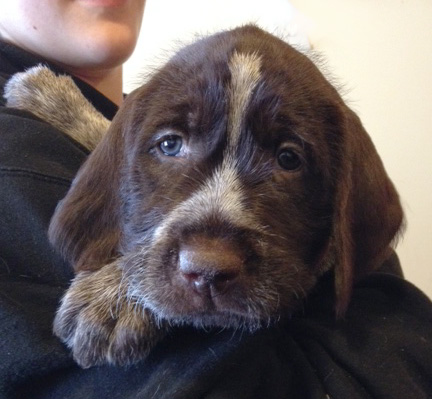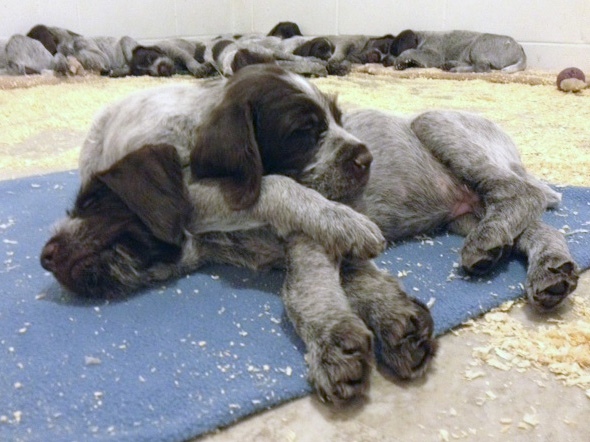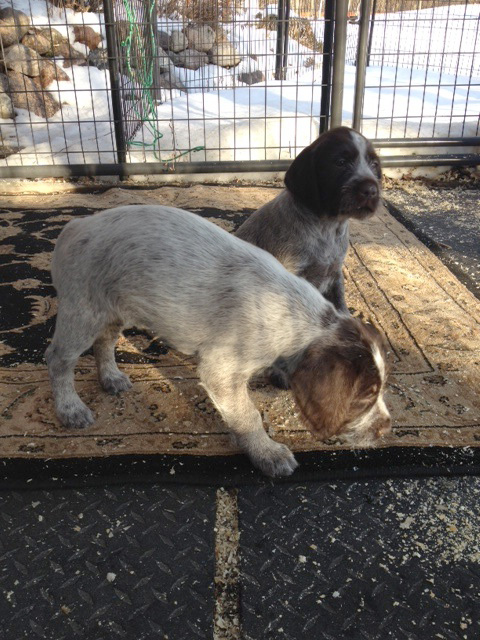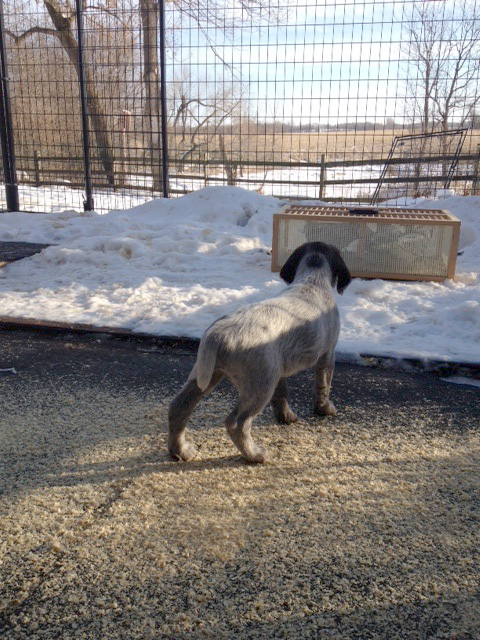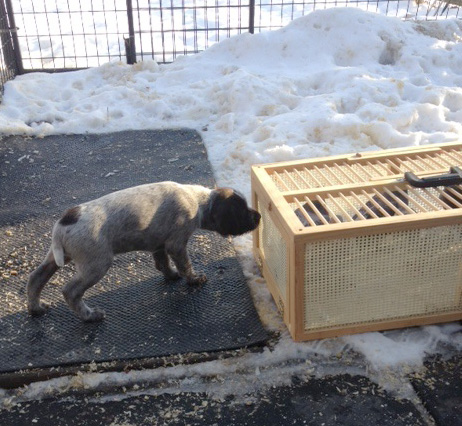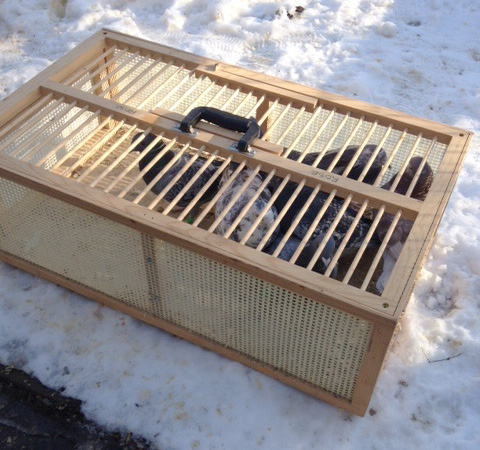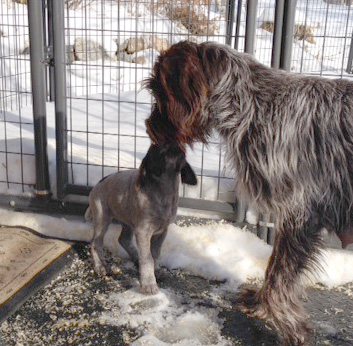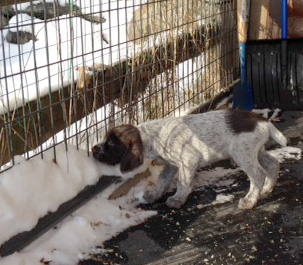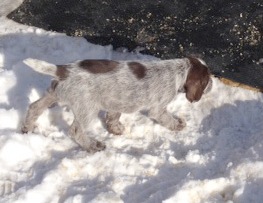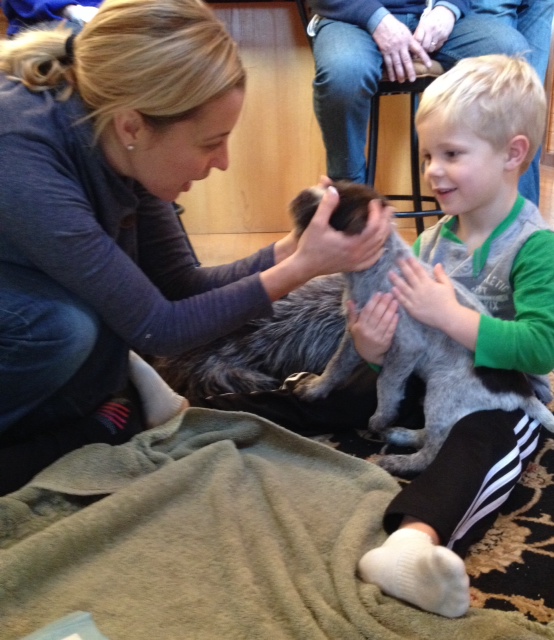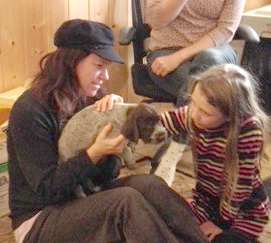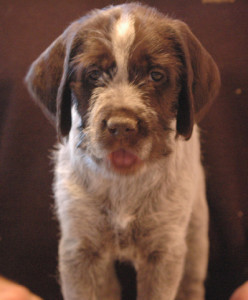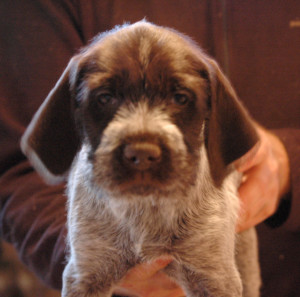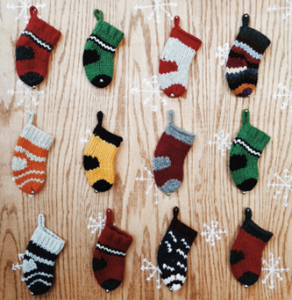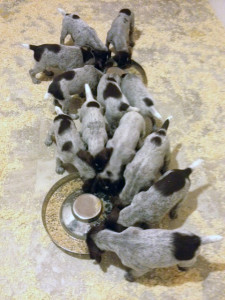All of the new toys introduced yesterday are getting a lot of play time, but the frog (which contains something that sounds like crinkly cellophane and a squeaker) is the big hit. I also found the puppies mesmerized when my phone’s reminder “ring tone” sounded. Their response to that tone was so interesting that I played through most of the others. Maybe it was a coincidence but many of them went to lay down for sleep. Whoda thunk that an iPhone’s features include nap signalling for canines?
Monthly Archives: December 2013
Quiet moment…
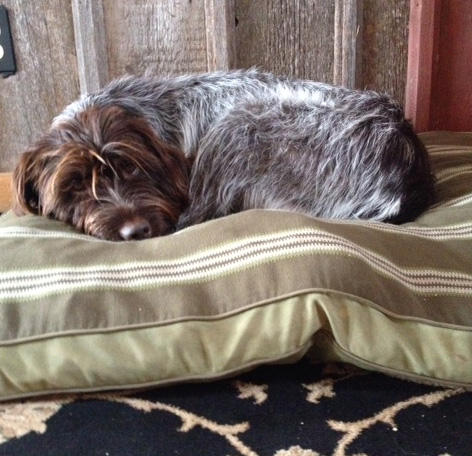 I know it won’t last long so I’m enjoying the quiet of this moment. Biff went into town and, as the puppies napped, I took Chev and Finley out to walk around in the backyard. It’s snowing lightly and the temperature has warmed up to 6 degrees (Farenheit). With no wind it seemed downright pleasant!
I know it won’t last long so I’m enjoying the quiet of this moment. Biff went into town and, as the puppies napped, I took Chev and Finley out to walk around in the backyard. It’s snowing lightly and the temperature has warmed up to 6 degrees (Farenheit). With no wind it seemed downright pleasant!
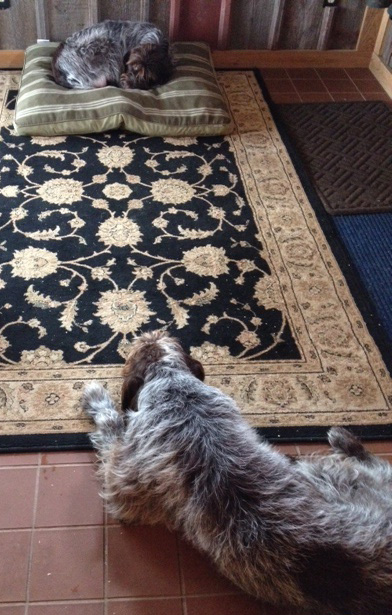 Now Chev and Finley are snoozing and I can type in some helpful info from the AKC’s “New Puppy Handbook”, a little publication that we’ll be sending home with each puppy’s new family. Here are some excerpts from the section, “Leaps & Bounds.” They offer these comments on 8 to 12 week old puppies:
Now Chev and Finley are snoozing and I can type in some helpful info from the AKC’s “New Puppy Handbook”, a little publication that we’ll be sending home with each puppy’s new family. Here are some excerpts from the section, “Leaps & Bounds.” They offer these comments on 8 to 12 week old puppies:
“Your puppy is getting his act together physically – he’s still quite roly-poly, but learning to coordinate his growing body well enough for playful jumping and tumbling. Toward his 12th week, he’ll start shedding puppy teeth as permanent teeth emerge. By his 12th week, bladder control is improving.
Like any baby, your young puppy needs to sleep for much of the day. Keep playtimes short and give him lots of ‘down time.’ Don’t force him to keep up prolonged activity and resist the urge to show him off to everyone right away!
Introduce ‘pre-training activities’ – Although your puppy has a very short attention span, you can begin gently developing a few basic behaviors such as wearing a collar, following on a leash, and coming when called. Keep each session about 3 minutes long, with the emphasis on fun, using plenty of treats and praise.”
Important ‘To Do’s’: Take your puppy out frequently. Give him safe chew toys. Start ‘pre-training,’ Keep up with vet visits.”
Puppy visitors
The Goff family and friends came to handle the puppies this afternoon. Between naps the puppies got plenty of attention. Good thing. The temperatures are below zero today so there was no chance of playing outside. The snuggle level inside was nice and toasty. Thanks, Goffs, et al, for driving out!
Look who else was snoozing today. The weeks of interrupted nights have taken their toll and Biff checked out for a couple of hours late this afternoon. Not a bad way to spend part of a sub-zero afternoon.
Outdoors again
The temperatures are up in the high 30’s and low 40’s until later today (when it is still expected to drop and stay below zero), so Biff took all the puppies out again in pairs, as he did yesterday afternoon, providing them all an opportunity to sniff around. The added element today was a crate containing pigeons, just to see how they would respond to the scent.
Venturing outdoors for the first time
The temperatures rose into the 30’s today, providing us an opportunity to get each of the puppies outside for their first outdoor experience. (Biff took a few of them out in his arms last week for just a few moments of fresh air. The temperatures have been ridiculously cold – and will be again in a few days – and staying out more than a moment or two wasn’t do-able.) But today the puppies were able to walk around for a couple of minutes. Thanks to Elaine for the outdoor photographs and to Megan for helping Biff and Finley keep an eye on them exploring.
We enjoyed meeting some new folks interested in Griffs this afternoon and enjoyed seeing great friends, Mark and Elaine with some of their family this morning.
“Pre-Puppy Preparation”
We want to offer these excerpts from the article, “Pre-Puppy Preparation” by Pat Miller from the September 2005 Issue of http://www.whole-dog-journal.com
“Stop! Don’t bring home that adorable pup until you are properly prepared.
Most people spend months preparing for the arrival of a new baby. They’re just as likely, however, to bring a baby dog home on a whim, without any preparation at all. Small wonder they find themselves playing catch-up for weeks, months, years, or even “getting rid of” the dog as they struggle to recover from the mistakes made in the pup’s formative months.
For example, a lack of a crate, puppy pen, or baby gates from day one makes housetraining “mistakes” inevitable. This can set back later housetraining efforts by weeks or even months, as the puppy is triggered to eliminate in spots where he smells remnants of his past “accidents.”
| Biff and I don’t use all of the items described in this article, but the big idea – that to be successful you will need to be consistent and will need to keep track of your puppy every minute – is key. Count on him/her needing to go outside to pee every 20 (or so) minutes during the first few weeks and always immediately after waking, eating, romping/playing. The hard work of house-training on the front end is well worth it. Register now for some type of puppy “Kindergarten” classes and plan to involve as many family members as they will allow. You’ll want to get going within a week or two of bringing your puppy home and classes fill, so find a series of classes that works into your schedule. It’s so much easier to train them when they’re small! |
“The wise puppy-owner-to-be puts much thought into pre-puppy preparation. When I was a preteen, my parents had the foresight one Christmas to put a gift certificate and a dog bowl and leash in a wrapped package under the tree rather than rushing out to buy the Collie puppy I’d been asking for as a living holiday gift. That gave us plenty of time to prepare for the new canine baby as a family, and to give our new dog a carefully structured introduction to our home.
Pre-puppy preparations fall into three categories:
• Supplies and equipment
• Service providers
• House rules and routines
Supplies and equipment
There’s lots of puppy stuff you’ll need to make your puppy comfortable, happy, and successful as he learns to adapt to your alien environment. The following is an abbreviated list from “A Dog Owner’s Hope Chest,” WDJ February 2002.
• Crate. A crate is an indispensable behavior management tool; it facilitates housetraining and prevents puppy misbehavior by keeping your dog safely confined when you’re not there to supervise. It allows you to sleep peacefully at night and enjoy dinner and a movie without worrying about what the pup is destroying. See “Crate Training Made Easy,” WDJ August 2000.
• Puppy pen/exercise pen. This is another extremely useful management tool, but it expands the “den” concept of a crate to a slightly larger area, giving a pup more room to stretch her legs, yet still keeping her in a safe, confined area. Many people include a “restroom” facility, by using a tarp underneath the pen and newspapers on top of that at one end.
• Tether. This is a short (about four feet in length) plastic-coated cable with sturdy snaps at both ends. Tethers are intended to temporarily restrain a dog for relatively short periods of time in your presence, as an aid in a puppy supervision and house- training program, and as a time-out to settle unruly behavior. They should not be used as punishment, or to restrain a dog for long periods in your absence. See “Tethered to Success,” April 2001.
• Collar, ID tag, leash, and harness.
• Treats. We use treats as the primary reward because most dogs can be motivated by food, and because they can quickly eat a small tidbit and get back to the training fun.
• Long line. A lightweight, strong, extra-long leash (10 to 50 feet), the long line is an ideal tool to help your dog learn to come reliably when called regardless of where we are or what other exciting things are happening. WDJ reviewed long lines in “Know Your Lines” and “A Few We Missed,” November 2001. We discussed training your dog to come with a long line in “Long Distance Information,” February 2001.
• Kong toys. If we could buy only one toy for our dog, it would be a Kong, a chew-resistant (not chew-proof) rubber, beehive-shaped toy with a hollow center. A Kong can be used “plain” as a toy, but makes an irresistible treat for any dog when stuffed with kibble or treats that are held in place with something healthy and edible like peanut butter, cream cheese, or yogurt. See “King Kong,” October 2000.
• Balls, interactive toys, fetch toys. See “Gotta Lotta Balls,” August 2001, “Toys to Keep ’Em Busy,” May 2004, “Terrific New Toys,” June 2001, and “Play (and Train) by Tugging,” March 1999.
• Grooming tools. Choose combs and brushes appropriate for your dog’s type of coat (ask a groomer or vet), shampoo and conditioner, scissors, nail clippers, cotton balls, and toothbrushes. Start using these tools on your puppy early, pairing the experience with tasty treats so she forms a positive association with the task.
• House cleaning tools. Use housecleaners without ammonia.
Service providers
It’s never too soon to start researching the corps of professionals who will help you raise your puppy right. That list will include her veterinarian (or veterinarians, including an emergency hospital, holistic vet, and “regular” vet), training instructor, and perhaps a groomer, pet sitter/walker, doggie daycare provider, and boarding kennel. Grab your phone book, make a separate list for each category, and check them out.
Start with a telephone call. If the provider can’t be bothered to be pleasant on the phone, chances are they won’t be nice in person either. Cross them off.
If they pass the phone attitude test, inquire whether you can visit, ask a few questions, and watch them at work. Then visit. Do they handle canine and human clients gently, and with respect? Are the dogs enjoying themselves, or do they at least appear comfortable? Are the facilities clean, without offensive odor? If the answers to these questions are yes, they stay on the list. If not, cross them off. Make notes next to each of the finalists on your list to remind you whom you liked best and why.
Finally, ask for references. Call the references and ask if they’ve been satisfied with the provider, if they seem reliable and consistently dog-friendly. Then pick your favorite animal care professionals, and let them know you’d like to become a client when your pup arrives. After you’ve made your final decisions, make a list of names, addresses and phone numbers to post on your refrigerator along with the phone numbers and locations of your local animal shelters – in case your precious pup should ever get lost.
House rules and routines
Rules and routines are especially important if there’s more than one human in the house, to encourage consistency, an important element of successful puppy-raising. When your pup joins your family, she’ll experiment with different behaviors to try to figure out how the world works, and how to make good stuff happen – a dog’s main mission in life. The more consistent everyone is, the quicker she’ll figure it all out.
Your rules and routines will reflect your dog-raising and -training philosophies. To develop a relationship with your dog based on mutual trust, respect, and cooperation, implement nonviolent management and training techniques, and avoid methods that require harsh verbal correction and physical punishment. The better you are at keeping your pup out of trouble and reinforcing desirable behaviors, the less you’ll be upset with her and the sooner she’ll develop good habits. (See “Secrets of a Happy Relationship,” August 2002.)
Here are some issues for your family to discuss and agree on:
• Where will your puppy sleep? We suggest in a crate in someone’s bedroom until the pup’s at least a year old and fully housetrained and house trustworthy; then her own bed or someone’s bed (or wherever else she wants) is okay.
• Will she be allowed on the furniture? We’re okay with dogs on the furniture within reason – not the kitchen table, of course – as long as it’s not creating any aggression or other behavior problems. We like our dogs to ask permission first if we’re on the sofa and they want to join us. (See “Is Your Dog Spoiled?” May 2003.)
• Where will she be during the day? The best answer is with you, if you have the luxury of working at home or taking her to the office with you, under direct supervision or leashed and crated, with potty breaks every hour on the hour, at first. If you’re not home, she should be indoors, crated – if you can arrange for adequate potty breaks – or in an exercise pen.
• What games will she be allowed to play? There are games, and then there are games! Good games like “Tug” and “Fetch” reinforce desirable behaviors. Inappropriate games like “Body-Slam the Human” and “Jump Up and Bite Skin and Clothing” reinforce undesirable behaviors. Be sure everyone in the family is on board with teaching appropriate games, and playing by the rules.
If family members insist on an inappropriate game like “Jump Up” (biting is never to be encouraged), get them to agree to teach polite behavior first, then teach “Jump Up” on a very specific cue – and allow it only on cue. (See “Fun and Games,” June 2003; “Games Puppies Play,” December 2003; “Mind Games,” October 2004; “Tug: Play It by the Rules,” October 2004.)
• Who will feed her; when, and what? Your pup should be able to depend on regular and high-quality meals from a clean bowl in a quiet place. If you choose to make it a child’s responsibility, you must supervise to be sure the dog is fed properly. Don’t allow anyone to pester her while eating. Rather, have family members walk by and drop extra-special treats in her bowl while she eats, to help prevent resource guarding. (See “Bowl Games,” August 2005 and “Thanks for Sharing,” September 2001.)
• Who will train her, how, and for what? We urge you to train using positive reinforcement methods, starting with housetraining (see “Minding Your Pees and Cues,” December 2001) all the way through the most advanced training you choose to pursue (see “Higher Education,” April 2004). You can have a “primary” trainer, and then encourage the whole family to participate in training activities; they’ll all be living with the pup, and they can all learn to communicate consistently and effectively in a language she understands (see “The Value of Training the Kids,” January 2002.)
Make a vocabulary list of terms your dog learns and post it on the refrigerator, so everyone uses the same behavior cues. Add to the list as she learns new behaviors. Remember that your dog is never too young (or old) to learn. Check out basic and advanced good manners training, agility, rally obedience, tricks, flyball, scent detection, musical freestyle . . . the possibilities are endless.
• How will you correct her for making mistakes? Positive does not mean permissive. If your pup is well supervised she shouldn’t have the opportunity to make many mistakes, but they will happen. When they do, calmly interrupt the pup’s behavior with a cheerful “Oops!” and redirect her to something more appropriate. Make a mental note to ramp up your management or training to prevent the situation from happening again.
Puppies develop lifelong habits during the first several months of their lives. Extra management effort early on can save you years of headaches later. If you don’t give your pup the opportunity to learn that chewing sofa cushions is fun and feels good on sore gums, she’ll earn house freedom much sooner than a confirmed cushion shredder. When you see her heading for cushions or the coffee table leg, offer her a stuffed Kong instead, or engage her in a game of tug.
If she’s driving you crazy, grabbing your pants legs, and biting your hands, say “Oops! Time out!” and put her in her exercise pen for a bit. This will give you both a chance to calm down without resorting to corporal punishment. When she realizes that biting makes the fun stop, she’ll learn to control her urge to grab.
Sound like a lot to think about? It should! Accepting responsibility for the life of another living creature requires serious thought and commitment. The way you care for your pup will determine whether she spends the rest of her life sharing companionship and love with you or, like too many dogs, gets passed from home to home in search of one where she will be better understood and appreciated. She deserves a lifelong loving home. They all do.”
Merry Christmas to all and to all a good night
We had a simple Christmas here with Chev, Finley, the puppies and neighbor Becci. Good food and good conversation in between puppy feedings, puppy cuddlings, puppy naps and (of course) clean-up sessions. All twelve puppies chase and wrestle each other more than ever. Many of them play with the chew toys. And then they all zonk out and we get about 3 hours before they all wake up and need to eat or play or poop or pee again. They’ll be 6 weeks old tomorrow!
A puppy Christmas
“‘Twas the night before Christmas and all through the house not a creature was stirring…”
Strike that. The creatures (all 12 of them) stir every 3 or 4 hours ’round the clock!
“… The stockings were hung by the chimney with care…”
Who’s had time to hang stockings?!
“And mama in her kerchief and I in my cap, had just settled ourselves for a long winter’s nap.”
This is our dream. We haven’t had a good night’s sleep since the first pup was whelped.
I’d love to go on with the Christmas poem but the puppies will soon be ready for lunch and I want to sneak in a shower before mixing up their meal. Despite the craziness, we know that we are blessed and these puppies will soon be with families that are ready and waiting for them. It’s all good!
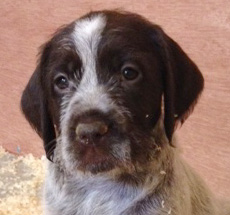 Merry Christmas to all from Norling Rise!
Merry Christmas to all from Norling Rise!
Big dogs like puppy toys, too.
This morning Biff returned from town with some additional puppy toys, a nice array that I thought would make a good photo. Chev noticed the toys and held motionless while I snapped a couple of pictures of the new assortment. I gave him a treat for the good “leave it” behavior and then put the toys up on the table and went off to do attend to something. Who did I find mouthing one of the soft new toys just minutes later? Yup, Chev. Poor guy. He released the object of his desire and got one more small treat. I’ve got to head into town this afternoon and think it’s time I get our boy a new toy of his own.
Evidence of growth
We fed the puppies from just one ringed pan this morning and it was evident that they had grown so much that all their little heads could no longer fit around one pan to eat. So, as of lunch time today, we began feeding them using two pans. Now they all have plenty of space and can get their fill without having to compete for their meals.

